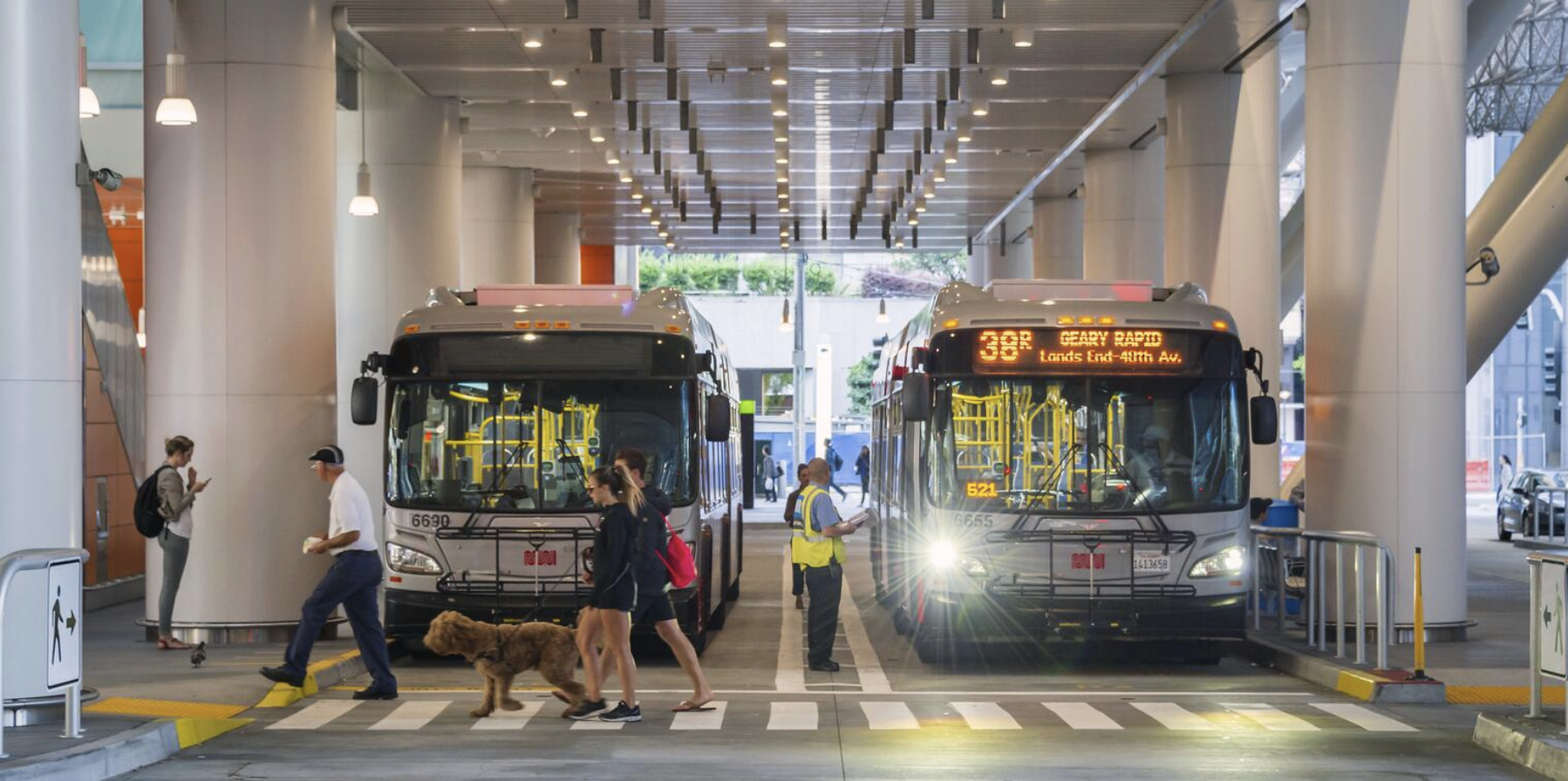Note: This post as originally published at SPUR. Reprinted here with permission
Last year, Governor Gavin Newsom and the California Legislature directed the California State Transportation Agency (CalSTA) to convene a statewide transit transformation task force to develop policy recommendations to grow transit ridership, improve the transit experience, and address long-term operational needs. SPUR has been appointed to serve on both the 25-member task force and on the supporting technical working group.
The effort is arguably the state’s largest foray into transit policy in decades and one that comes at a pivotal time for systems that are still struggling to regain ridership and stabilize their financial footing post-pandemic. It also comes at a moment when the state is grappling with how to actually achieve the significant reductions to vehicle miles traveled (VMT) and corresponding increase in transit ridership that will be needed if California is to achieve its ambitious climate commitments. SPUR believes that the task force has a unique opportunity to address both of these challenges by charting transit’s transition to a sustainable business model.
How? By spending the next year:
- Clarifying and aligning the state’s ambitious policy goals for transit
- Identifying and planning for adequate state funding to support a reduction in VMT and increase in transit use
- Assessing the operational capacity transit will need to efficiently deliver on the state’s goals
- Developing a realistic implementation strategy that focuses on the role of the state and that is rooted in quantified analysis and critical thinking about geography, scale, and time
Transit needs a business model that supports the state’s policy goals
A transition to a sustainable business model for transit is about more than just finding the funding to keep the existing transit system going. It starts by identifying what the state wants and needs transit to do. This task isn’t simple.
California has accumulated a wide range of laws, plans, and regulations that set varied policy directions for the more than 200 transit agencies operating in the state. But with Assembly Bill 32 in 2006 and more recently Senate Bill 375, S.B. 35, and A.B. 2334, state legislation has increasingly focused on transit as foundational to broader social and environmental goals, such as reducing greenhouse gas emissions, expanding access to opportunity, supporting housing development, and reducing gridlock. As these laws have been interpreted and quantified through specific plans and regulations such as Plan Bay Area and the California Air Resources Board Scoping Plan, it has become apparent that California’s goals necessitate a transit system that is both bigger and much more heavily used than today’s system.
Last month, the task force began investigating how transit will need to change to support the state’s climate goals. CARB’s Scoping Plan sets targets of a 25 percent reduction in VMT by 2030 and a 30 percent reduction by 2045 relative to 2015 levels. Achieving these reductions by shifting drivers to transit would require as much as a five-fold to ten-fold increase in transit ridership above pre-COVID levels by 2045 (implying sustained annualized growth rates of 10 to 15 percent) or a still-ambitious four-fold to six-fold increase with a strategy targeting reduction of longer trips that disproportionately generate VMT. This level of growth in transit ridership lies far beyond any historical trend and also significantly exceeds the (already very ambitious) projections for transit ridership growth included in the sustainable communities strategies of the state’s largest regions. Achieving this kind of growth — or anything even approaching it — will require a massive shift in transit’s business model.
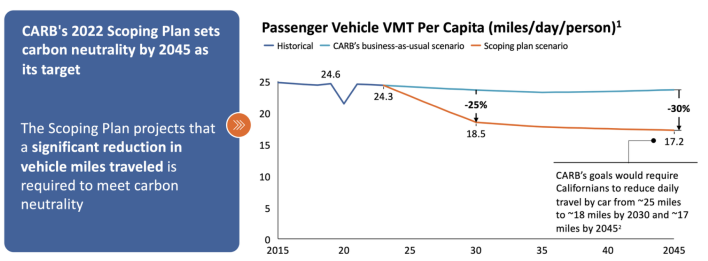
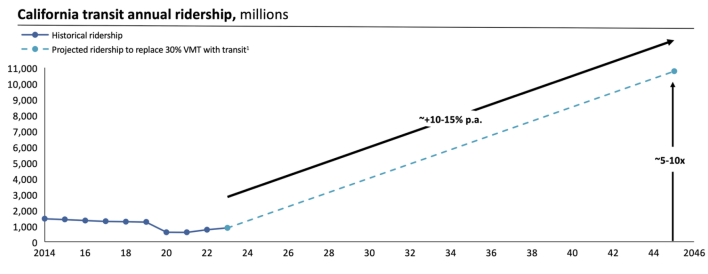
Scaling up transit’s business model requires more funding
Increasing transit ridership above pre-COVID levels at the massive scale implied by the state’s goals requires a correspondingly large expansion of the absolute amount of frequent, reliable, and safe service available to Californians. That takes funding — a lot of it. While there is variation between individual agencies and services, the extremely strong correlation between the provision of service (measured in service hours), the cost of operations, and ridership holds true for transit agencies across the United States.
The figures below show that ridership, quantity of service, and total operating costs are strongly correlated, meaning much more funding will be needed if California is to grow its transit ridership five-fold to ten-fold.
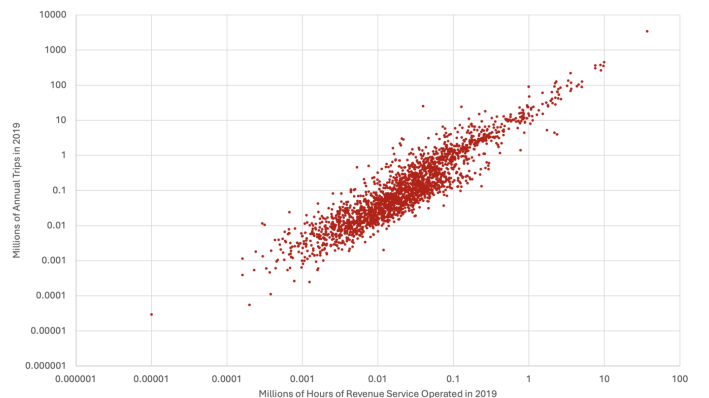
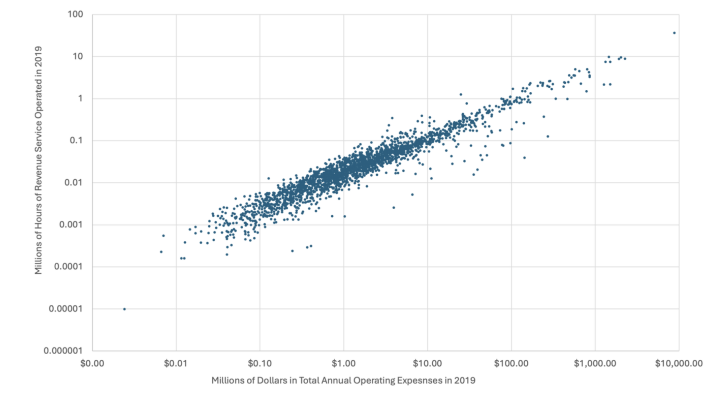
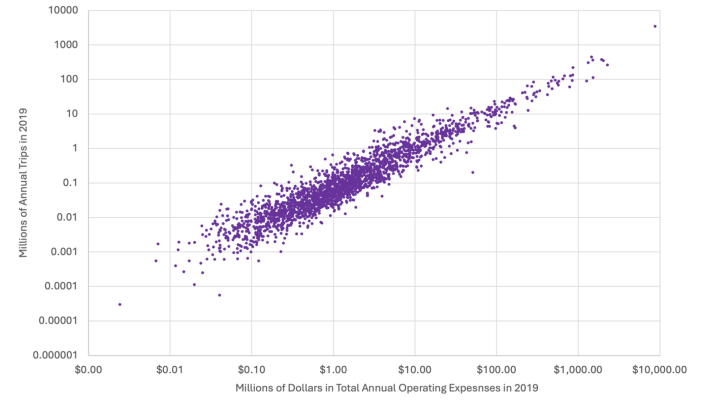
In 2019 (the last full year of transit financial operating data prior to the injection of significant one-time federal relief funds into transit operations nationwide), the National Transit Database (NTD) showed that transit operations across California were a $8.2 billion endeavor. These operating costs were paired with annual capital investments to maintain and expand the system, averaging just more than $5.3 billion annually between 2018 and 2022. The state and transit operators can, and must, look for ways to cost-effectively grow systems and make them more efficient, but growing overall transit ridership by a factor of 3, 5, or 10 will inescapably require an enormous increase in public resources. In fact, recent academic research has shown that metropolitan regions in the United States with highly productive transit systems (as measured by passenger miles traveled per miles of service provided) are also the regions where the per capita level of public subsidy for transit is highest.
In this context, California’s commitment to funding its policy goals for transit has not kept pace with the scale of its ambitions. Despite a generous commitment of one-time relief funds for transit in the last state budget cycle, the state has historically been a minority funder of both transit operations and capital expansion. Local sources, self-generated revenues, and the federal government play a larger role in funding operations and capital improvements.
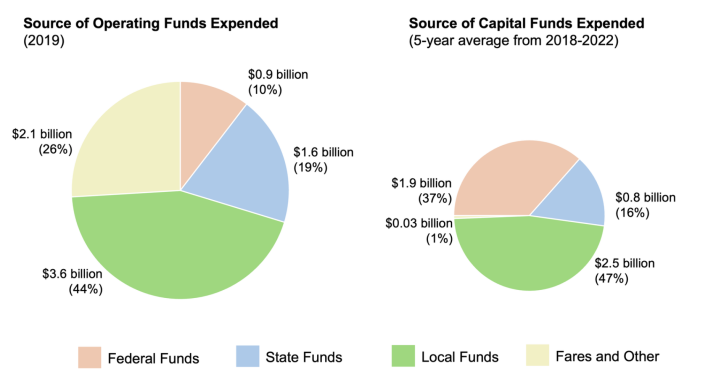
Additionally, California does not fund its largest transit systems at the same level that many East Coast states with large cities do. SPUR research shows that state funding represents a smaller proportion of overall transit funding for large California systems like Bay Area Rapid Transit than it does for major East Coast systems like the Southeastern Pennsylvania Transportation Authority or the Massachusetts Bay Transportation Authority.
A sustainable business model also requires more operational capacity
The state’s goals for a significant increase in transit rely on the collective operational capacity of transit agencies and other government organizations. The challenge of building government capacity is tied to the availability of funding, but even with new funding, transformation can’t happen overnight.
This issue of operating capacity is playing out right now across the Bay Area, the state, and the overall transit industry in myriad of ways. On the front lines, operators are struggling to hire bus drivers, mechanics, and other employees due to a combination of high housing costs, job quality and safety concerns, and wage competition from other sectors. Similarly, the ability to deliver capital projects quickly and cost-effectively is a well-documented and complicated capacity challenge, one that contributes to project delays and higher costs. Even the push to transition transit operators to zero-emission vehicles has faced significant supply-side challenges. In short, government and private sector capacity issues playing out across the transit industry are making it harder for the state to realize its ambitious policy goals, particularly in a short timeframe.
Transforming transit to meet the state’s goals will take strategic leadership from the state
The state is only one layer in the complex system of overlapping federal, regional, and local government bodies, laws, and policies that produce transit. Achieving a sustainable business model to transform transit — aligning the state’s goals with resources and operational capacity — will require a carefully executed strategy that is maintained with mutually reinforcing actions from the governor, the legislature, CalSTA, the California Transportation Commission, and other state agencies.
Our hope is that the Transit Transformation Task Force not only identifies recommendations for the legislature, but also creates a realistic, evidence-based, and time-bound implementation plan. To be effective, this plan must be sensitive to the very real differences in geography, scale, and time that necessarily will require the state to make hard choices.
Take the issues of geography and scale. Transit is important everywhere, but SPUR analysis of National Transportation Database data shows that more than 80 percent of ridership in the state is concentrated on less than 5 percent of its transit systems. Dense urban areas and productive long-distance corridors linking key destinations are where transit can achieve the best near-term performance — the highest ridership and the greatest shift of vehicle miles traveled. That does not mean that other types of transit are unimportant, but it does imply that policymakers need to make real, data-informed choices about where they focus limited resources to advance the state's goals. At the same time, doubling or tripling ridership on a mature urban system like the San Francisco Municipal Transportation Agency or Los Angeles Metro involves very different practical considerations than it does on a small rural system — considerations that require realistic analysis and discussion.
Time also matters. Climate change is not on a government schedule, and the urgency is real. CARB’s target dates for achieving massive VMT reductions are just a few years away. Time must be a key factor in how the task force and government think about the strategy for transforming transit. In the near term, government capacity, just as much as funding, is going to limit how fast transit can change, and that capacity is metered in many different places, from the size of the labor force to the individual workload of key leaders to the rhythms of government and the pacing of legal processes. Even as agencies work to change these limits, we have to be realistic about the ability of the collective system to pivot and the reality that transit is one of many issues that competes for resources and attention.
SPUR supports the state’s ambitious environmental and social goals and wants to see transit play a much bigger role in meeting them. We are glad to see CalSTA taking a leadership role in outlining a program of work for the task force that grapples with the reality of what it would actually mean to resource and implement an aggressive transformation of transit.
Laura Tolkoff is Transportation Policy Director, and Sebastian Petty is Senior Transportation Policy Advisor for SPUR.
